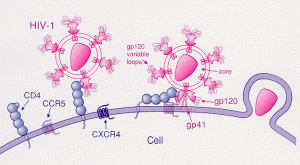An ongoing dialogue on HIV/AIDS, infectious diseases,
October 14th, 2013
MODERN Study Stopped: An NRTI-Sparing, Two-Drug Initial Regimen Disappoints Again
 In case you didn’t know, “MODERN” is the clever name for the “Maraviroc Once-daily with Darunavir Enhanced by Ritonavir in a New regimen” trial, which compared TDF/FTC to maraviroc, both with boosted darunavir.
In case you didn’t know, “MODERN” is the clever name for the “Maraviroc Once-daily with Darunavir Enhanced by Ritonavir in a New regimen” trial, which compared TDF/FTC to maraviroc, both with boosted darunavir.
And once again, the NRTI-sparing two-drug regimen comes up short, this time in a fully powered, double-blind noninferiority study.
From a PDF provided by ViiV’s Regional Medical Scientists (the information isn’t on the company’s website yet), here are some pertinent details:
- The study included 791 treatment-naive patients; all had CCR5 virus at baseline.
- At week 48, 72% and 83% of the MVC and TDF/FTC patients had HIV RNA < 50 at week 48 (∆=11%, 95% CI –17.1% to –6.1%; the pre-specified criteria for noninferiority stated that the lower bound of the 95% CI be greater than –10%).
- Thirty-eight patients in the maraviroc (MVC) arm and 13 in the TDF/FTC arm experienced treatment failure.
- No new safety issues were identified in either treatment arm.
- Data are still being analyzed, with further information to come.
As noted before, the bar for successful initial therapy these days is set extremely high, with several recent studies demonstrating 85–90% suppression rates at 48 weeks using regimens with low pill burdens and excellent tolerability. 72% just isn’t going to cut it.
And for the record, here’s a list of NRTI-sparing studies that gave “meh” results at best:
- ACTG 5142 — LPV/r + EFV vs NRTIs + EFV vs NRTIs vs LPV/r.
LPV/r + EFV had high rates of hyperlipidemia; regimen was also cumbersome with lots of GI side effects. - SPARTAN — ATV + RAL vs ATV/r + TDF/FTC.
More treatment failure, more jaundice in the ATV + RAL arm. - PROGRESS — LPV/r + RAL vs. LPV/r + TDF/FTC.
Comparable success rates, but baseline HIV RNA low in the study population; 3 pill, twice-daily regimen. - ACTG 5262 — Single-arm study of DRV/r + RAL.
Unexpectedly high rates of virologic failure (with resistance), especially among those with HIV RNA > 100k at baseline. - A4001078 — ATV/r + MVC vs ATV/r + TDF/FTC
Only 75% virologic suppression rate in ATV/r + MVC arm, with more hyperbilirubinemia than the control group; study not fully powered. - RADAR — DRV/r + RAL vs. DRV/r + TDF/FTC.
63% suppression rate in the RAL arm, vs 84% for TDF/FTC; study not fully powered.
What remains unclear is why these two-drug regimens have been so disappointing. Is two drugs not enough? Or maybe just the two drugs tested to date in these clinical studies? Is there something magic about the NRTIs? Or certain NRTIs? (One vote could be for 3TC or FTC, which have been part of every truly great HIV regimen since the late 1990s.) Do the benefits in bone density for the NRTI-sparing strategies outweigh the lesser virologic activity? (My opinion — no.)
Regardless, HIV clinicians and researchers eagerly await the result of two completed but not yet presented clinical trials — the fully-powered NEAT study comparing RAL to TDF/FTC (both with DRV/r), and the GARDEL study, comparing 3TC to NRTI/3TC (both with LPV/r).
Until then, one should be using NRTI-sparing therapies as initial treatment only in highly select circumstances — and even then, why not include 3TC or FTC?


What are your thoughts then on the SECOND line and OPTIONs trial that was presented at CROI. That was looking at nuke-sparing regimens that had more active non-nuke regimens and seemed to do well.
Astha2,
Of those two studies, only Second Line was analogous since in OPTIONS, they had more than 2 active drugs. And in Second Line, the baseline viral load was pretty low, and the comparator arm did just as well even though it used “recycled” NRTIs.
Paul
Dear Paul,
Brilliant, as usual.
I’ve always used the 300 mg QD dose of MVC when co-administered with a PI/r in selected patients in need, until having data coming from the 1095 Study. Without significant extra toxicity (postural hypotension?), PK data with 300 mg QD were more reassuring than with 150 mg QD.
In the recent EACS Conference in Brussels, some data from the MITOX Study have seen the light and probably will give some clues about the reason for the failure seen in MODERN. It was a switch study from 2 NRTIs + PI/r to MVC + PI/r. 6 out of 40 patients receiving MVC + PI/r failed, and 4 of them received DRV/r + MVC, and 3 of them had insufficient MVC levels at failure. Levels of MVC were lower in those treated with DRV than with other PIs (p=0.045), and RTV levels were significantly lower among those treated with DRV (p=0.028).
Therefore, insufficient RTV boosting due to lower RTV levels and subsequent MVC levels could be the reason underlying this unexpected disaster.
Josep, many thanks for the interesting reference — it could be this is a dose problem, which of note bedeviled vicriviroc development too. Something up with CCR5 antagonists and finding the right dose, perhaps?
Paul